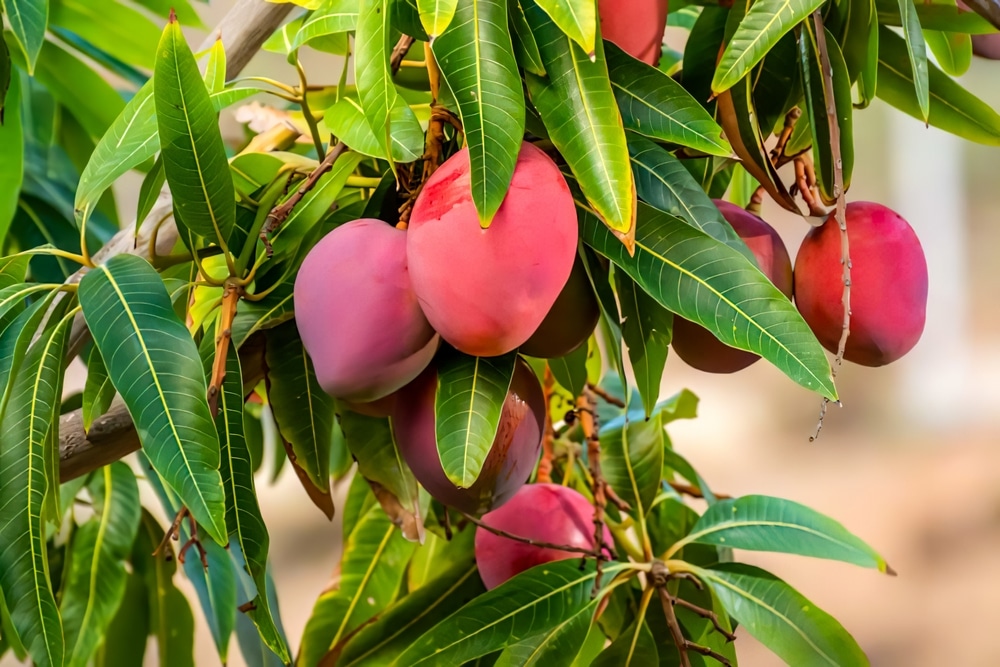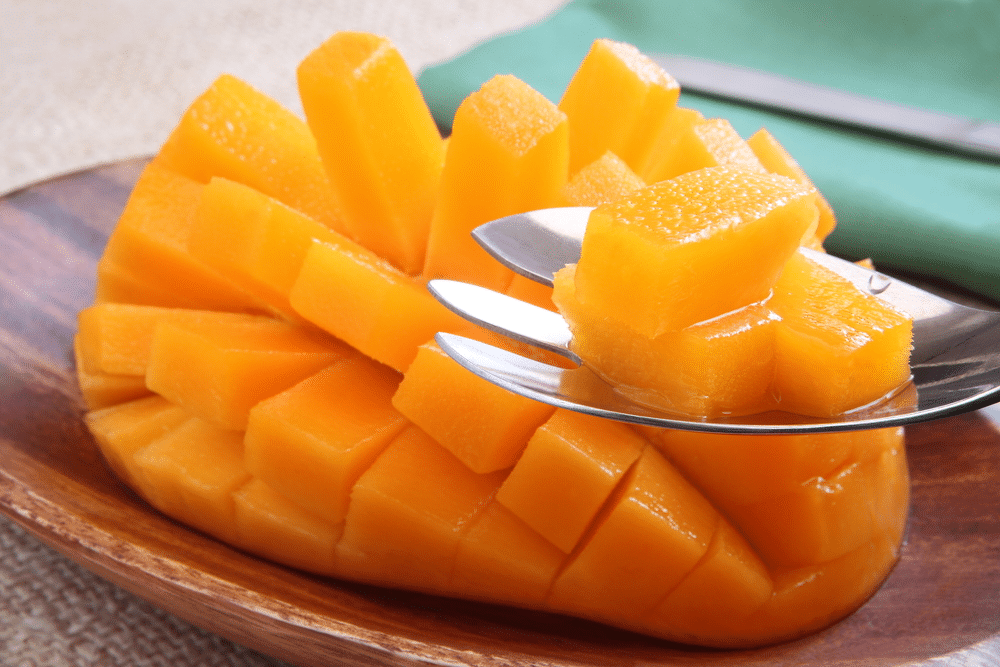Table of Contents
Japanese mangoes hold a special place in the world of mangoes as mango is known as the king of fruits; likewise, the Japanese mangoes, specifically those grown in the Miyazaki Prefecture, are considered the king of mangoes. With its wide range of tastes and textures, each bite of this world’s most expensive mango is more than just food; it’s a sensory journey. It is highly demanded by mango lovers in Japan and equally liked by people worldwide due to its unmatched sweetness and smooth texture. Although it is an expensive mango variety, those who have tasted it claim that a single bite is worth the money spent.
Miyazaki Mangos
The Miyazaki Prefecture is known for producing mangos’ finest quality and flavor. Ideally situated in the warm weather of Miyazaki City, Japan, these mango trees yield remarkable quality fruits, particularly between April and August. Of all the mango varieties grown in this area, one is particularly well-known—it’s called Taiyo no Tamago, or the “Egg of the Sun.
Cultivation and Harvesting

Japanese mango cultivation involves careful attention to detail. To ensure ideal growing conditions, farmers constantly monitor variables, including temperature, water levels, and soil nutrients. Mango trees are frequently grown in orchards, receiving proper care and maintenance throughout the year.
Depending on the type and area, harvesting usually occurs from April to September. Bright colors, smooth texture, and an intense aroma indicate the perfect mango ripeness. At this point, mangoes are hand-picked. This careful selection technique ensures that only the best fruits are harvested.
Distinctive Characteristics
Several characteristic features distinguish Japanese mangoes as follows.
Taste
Japanese mangoes are well-known for their remarkable sweetness and variety of taste profiles, making a pleasant meal. Their taste is unparalleled whether eaten fresh or used in other dishes.
Texture
Japanese mangoes are low in fiber and have a smooth, creamy texture. This makes them extremely enjoyable to eat, as each bite melts in the mouth.
Aroma
Japanese mangoes have a tempting scent that fills the air with a fragrant sweetness. It is one of the characteristics that makes them unique from other kinds.
Appearance
Japanese mangoes are visually attractive, with vibrant colors ranging from blush orange to bright yellow. Their plump shape and smooth skin enhance their visual appeal.
Varieties of Japanese Mangoes
Numerous varieties of mangoes are grown in Japan, each having unique characteristics. Among the most well-liked kinds are:
Taiyo no Tamago (Egg of the Sun)
This Japanese mango variety is prized for its intense sweetness, smooth texture, and rich flavor. Taiyo no Tamago mangoes are typically large, with vibrant orange-yellow skin and minimal fiber content. With an average weight of 350 grams per fruit, mangos’ ideal sugar content allows them to maintain the ideal sweetness-to-acidity balance.
Irwin
Irwin mangoes are known for their incredible juiciness and well-balanced sweetness. Mango lovers prefer them for their tasty flesh and lovely aroma. They usually range in size from medium to large, with a reddish-orange blush to their skin.
Keitt
Keitt mangoes possess a valued reputation for their low fiber content, firm flesh, and gentle sweetness. They are harvested late in the season, even when fully ripe, t retaining their characteristic green skin. Keitt mangoes have a tangy flavor and are famous for both fresh consumption and culinary uses.
Embracing Japanese Mango Culture

Mangos have a special place in Japanese culinary culture. This fruit, called “mango” or “mango in Japanese,” symbolizes richness and luxury. Miyazaki mangoes enrich any culinary creation—from desserts to savory dishes—by adding an element of refinement and richness. Every mango travels a path of perfection from the orchards of Miyazaki Prefecture to the shelves of marketplaces across the globe, ensuring that only the best examples reach the sophisticated consumer. People regard them as the epitome of luxury in the fruit world due to their quality and taste.
For people who are lucky enough to eat Miyazaki mangos, each bite is a moment of pure happiness. This Japanese treat always wins over the hearts and palates of foodies with its superior flavor and unmatched quality. As one eats into Taiyo no Tamago’s juicy flesh, one becomes amazed by the Miyazaki Prefecture farmers’ skill in turning the common mango into a delightful culinary masterpiece.
Japanese mangoes are renowned for their superior quality and elegance. Their exceptional flavor, fragrance, and texture attract premium prices in the country and globally. These fruits are in high demand in Japan, particularly around holidays when people exchange gifts and during special occasions like weddings and New Year’s celebrations.
Culinary Uses of Japanese Mangoes

People use Japanese mangoes in a wide range of dishes and also consume them raw due to their remarkable flavor, juiciness, and sweetness.
Fresh Consumption
Eating fresh Japanese mangoes is the easiest and most enjoyable way. They’re a tasty and excellent snack, either sliced or diced. Their sweet and juicy flesh adds flavor to fruit salads or yogurt parfaits.
Desserts
People frequently use Japanese mangoes in desserts because of their natural sweetness and striking color. They make custards, ice creams, mango sago, puddings, and sorbets. Mango cheesecakes, pies, and tarts are popular options that give traditional sweets a tropical twist.
Smoothies and Juices
Blending Japanese mangoes with other fruits like bananas, strawberries, or pineapple makes tasty, nutrient-dense smoothies. The creamy, sweet texture of drinks makes them richer. Cocktails and mango lemonade are other excellent choices to beat summer’s heat.
Sauces & Dressings
Baked Goods
Japanese mangoes can enhance baked goods such as muffins, cakes, and bread. Mango dice adds bursts of moisture and sweetness to cake or muffin dough. People frequently enjoy mango bread as a popular dessert for breakfast or as a snack.
Savory meals
Despite their traditional association with sweetness, mangoes add complexity and balance to savory meals. Mango chutney is a relish that works well with curries or grilled meats. Prepare mango chutney by using mangos, vinegar, and spices. Mango salads in a Thai style, made with mangos, veggies, and a zesty sauce, provide a cool contrast to spicy cuisine.
Drinks and Mocktails
Japanese mangoes’ tropical and delicious flavor makes them a great addition to drinks and mocktails. Daiquiris, mojitos, and mango margaritas are common choices for alcoholic beverages. Mango smoothies, mocktail spritzers, and mango-infused iced teas are great non-alcoholic alternatives.
Conclusion
Few fruits in the world can match Japanese mangos’ unparalleled sweetness and delicate flavor, especially those cultivated in the Miyazaki Prefecture. Japanese mangoes have established a reputation as the epitome of luxury and indulgence due to their association with Miyazaki City’s warm climate and the refined palates of consumers around the globe. With every bite, you can take your senses on a trip and enjoy the taste of perfection that the farmers of Miyazaki worked so hard to grow. The next time you see a Miyazaki mango labeled “Taiyo no Tamago,” don’t miss the chance to savor the best taste in food, a taste that melts in your mouth.

